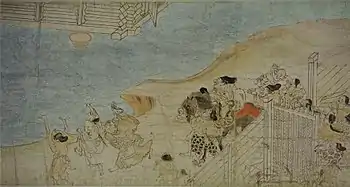Shigisan Engi Emaki
The Shigisan Engi Emaki (信貴山縁起絵巻, lit. "Legend of Mount Shigi Emaki") is an emakimono or painted handscroll made in the second half of the 12th century.[1][2] The story details miracles which were attributed to the monk Myōren, who lived on Mount Shigi near Nara in Japan in the latter part of the 9th century.[3]

The tales are composed in the genre of engi. Engi is a narrative that chronicles the founding of a Buddhist or Shinto establishment which, in the case of the Shigisan engi, is Chōgosonshi-ji, where Myōren used to live. The tales are painted in a style called otoko-e, or "men's pictures", a style characterized by active movement, outdoor scenes and a certain feeling of lacking restraint. Otoko-e is part of a larger style of Japanese painting called yamato-e. The work is also a prime example of Heian scroll painting, as well as of yamato-e, since most of the early yamato-e and scroll paintings are nowadays lost.[1]
References
| Wikimedia Commons has media related to Shigisan Engi Emaki. |
- Akiyama, Terukazu (1961). Japanese painting. Geneva: Skira. pp. 75–79. Translated from the French by James Emmons
- Shimizu, Yoshiyaki (1985). "The Shigisan-engi Scroll, c.1175". Pictorial Narrative in Antiquity and Middle Ages (PDF). National Gallery of Art. pp. 116–128.
- "Shigisan engi emaki". Encyclopædia Britannica. Retrieved 2009-01-22.
